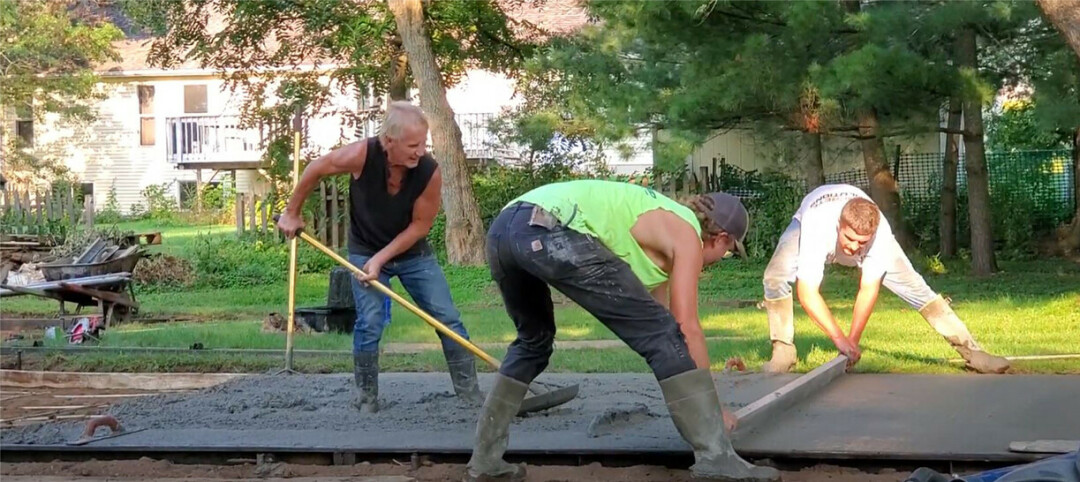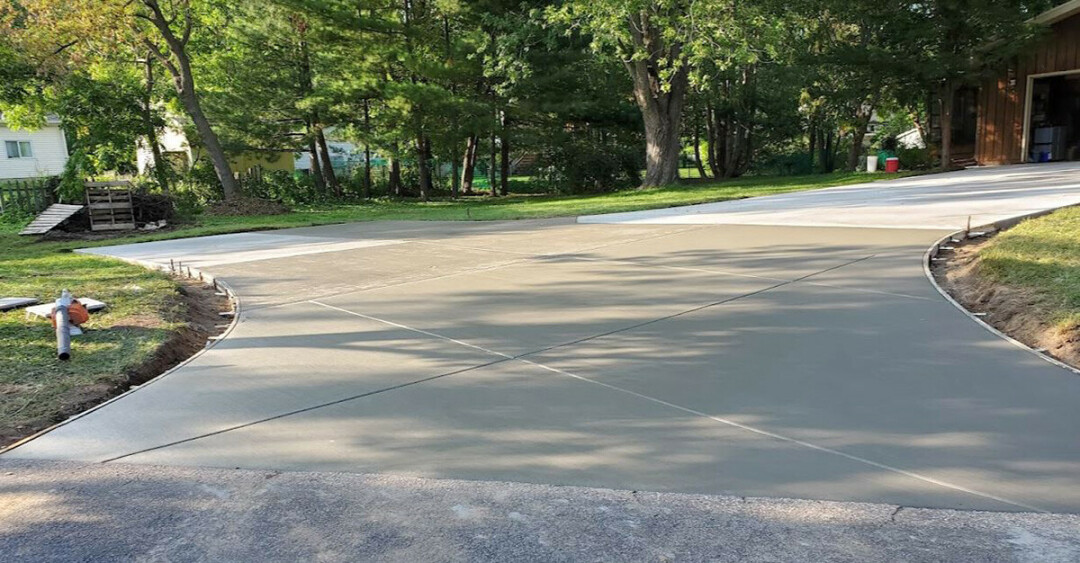SOLID EFFORT: Getting Concrete Work is a Multi-Stage Process
homeowner finds the process takes time, but is worth it at midcentury house

Asphalt or concrete? That’s what I was googling in January 2022 as I was pondering my driveway come summer. The asphalt driveway that came with the 50-year-old midcentury modern home I bought in 2010 was well beyond its useful life. To complicate matters, I had a pair of concrete steps – in front and in back – that needed work, while the back sidewalk had been mud-jacked and continued to slope downward despite annual efforts at landscaping to keep moisture at bay in the foundation.
Next, I reached out to homeowners whose asphalt or concrete work I admired. One emailed me their contractor’s info. But because of post-COVID pent-up demand, I never heard back. Many contractors then had more than enough work. Another let me know her work had been done by her son who had a concrete company. He retired recently, and her grandson bought it with his dad as a consultant.

So I got three bids for each; six bids in all. Oil prices were rising, which impacted asphalt’s usual lower cost. With concrete, I’d only need one rather than two contractors. After working with a dozen contractors over a two-year period to repair, rehab, and renovate my home (which was allegedly designed by a student of Frank Lloyd Wright), I wanted to simplify. My research showed that concrete has a longer lifespan than asphalt and requires less maintenance, although my civil engineer brother pointed out that “concrete cracks” and the initial work takes longer due to the required cement curing.
So I chose Concrete Solutions by Hospitality Inc., a local and family-owned firm, which could handle everything.
Alex Smith, the grandson, had grown up “slinging mud,” as he called concrete, since childhood with his dad John, the business’s former owner. He graduated in finance from UW-Milwaukee, and after working in that field, he soon realized he preferred to work outdoors. Alex sought out longtime childhood friend Matt Wells, now an experienced mason, to join him. Matt had worked for Alex’s dad throughout high school and a few years after building hotels and doing commercial work. He also studied finance at UW-Milwaukee and chose to leave before graduating in order to continue working in the concrete and masonry trade he knew and loved. Prior to returning to Eau Claire to join Alex, Matt worked as a mason for six years for a commercial company in Milwaukee. Both Old Abes, they had graduated from Memorial High School, my alma mater, which was a plus. Work would start the Tuesday after Labor Day.
My research showed that concrete has a longer lifespan than asphalt and requires less maintenance, although my civil engineer brother pointed out that “concrete cracks” and the initial work takes longer due to the required cement curing.
Prep Work. Prior to the start date, I needed to move things away from the driveway, steps, and sidewalk, as well as cover my three-season porch and front and back doors with plastic. (Fortunately, I found two guys to help, as I have no idea how I would have done that alone.)
Day 1: Excavation. Digging and breaking up the asphalt and concrete, hauling it away, and leveling the remaining earth, is noisy and labor-intensive. A skid steer, a truck, and six men. The skid steer drivers buzz back and forth. Time and speed are of the essence. When the concrete is really tough and in a place the skid steer can’t reach, they call in an experienced old-timer named Mike Waterhouse whose form is Olympian. At five-and-half-feet tall and 150 pounds, he knows his physics for sure. When he swings the sledgehammer up and brings it down on the concrete sidewalk that has been cracking away since the early 1970s, it’s a sight to behold. With a solid contact, he shatters the concrete into several pieces that are then hand-carried to a wheel barrow, which is then pushed and unloaded into the bucket of the skid steer, which is then raised up and emptied into the truck’s bed.
Day 2: Forming. Today’s focus is measuring, leveling, staking, and determining where the slabs of concrete are going, and how it will look afterward – kind of like cake batter for a cake pan, only my driveway is a geometric puzzle of squares and rectangles with a few curves thrown in. Four-inch steel forms are used to outline each area, while four-inch plastic bendable forms are used for the curves. To reinforce the concrete, fiberglass rods, which come 10 feet long and one-half-inch in diameter, are cut to fit, and suddenly, my driveway looks ready for a huge tic-tac-toe tournament.
Day 3: The First “Pour.” As a little girl, growing up in a construction company family, I recall my dad talking about “pours” on his bridge projects. While I knew they were very dependent on weather and temperature, I had never seen one for myself. So I was excited to pull up a lawn chair and observe as the American Materials cement truck from across the river rumbled down the street and arrived at my driveway with its bells clanging and its mixer turning and churning. Noisy? You bet!

Alex, Matt, and Mike quickly change out of their work boots and shoes into rubber boots. As the concrete starts sliding down the chute – which looks like the nose of an anteater – into the formed area, the men busily start dancing and raking and sweeping the concrete where it needs to go. As it comes down, they sometimes motion to the driver of the cement mixer to halt so they can finish their work. Then they signal to start up again, and down slides the cement, all squishy, wet, and gray. The entire process of them moving the cement where it needs to go and then compacting it out reminds me of a game of curling or the stomping of grapes to make wine.
Once the initial layer of “mud” is battened down, then Alex and Matt follow up with an extremely long bar called an aluminum screed. With a man on each end, they smooth out the top layer, over and over and over again. Matt follows up with a bull float, a tool with an incredibly long handle attached to a flat board, and moves it back and forth several times, slowly and surely, again to compact and smooth the concrete. More post-work follows with smaller hand tools to ensure the concrete is ready to cure. Three more pours take place that day as my new driveway comes to life.
“Concrete is an amazing material to work with,” comments Alex. “While it comes out liquid and mushy, it does not solidify instantaneously, so you have time to massage it, so to speak, into the shape you want it take in the end.”
“Concrete is an amazing material to work with. While it comes out liquid and mushy, it does not solidify instantaneously, so you have time to massage it, so to speak, into the shape you want it take in the end.”

Day 4: More Pours. The driveway gets finished, and then the mud is wheelbarrowed to the sidewalk in back due to its location. Like the driveway, each square of cement is smoothed out methodically.
Work ends mid-afternoon due to a rain forecast, and when the rain comes, it’s a downpour.
Matt, the mason, oversees the two “steps” jobs. He carefully measures and levels and frames the shape of each step with plywood forms, which are taken away after the concrete mud has taken shape to cure for a week. The steps end up as perfectly shaped rectangles.
Day 5: The Last Pour. After a weekend of rain and some sun, there is one last pour for the front steps. Mud is wheelbarrowed back and forth from the driveway. Finally, the caution tape goes up, and the concrete starts to cure for the required seven days. To play it safe, I choose 10 days.
Post Work: With my handyman, Mike, we seed the soil for grass to grow on the firm edges of the new concrete, and I carefully water to ensure the grass grows. Time will tell, though. My plastic installer, Darwin, arrives to take it down. The sheets are covered with dust and dirt, so good call to do that.
The Bottom Line: While my driveway is curing, I look at it and say to myself, “it’s beautiful, so beautiful.” Then when I drive on it, even better. Plus, with a midcentury modern home – and Frank Lloyd Wright’s love of cement buildings like Fallingwater in Pennsylvania and the Unity Temple in Illinois – I know concrete was the right choice for me.
Learn more about Concrete Solutions by Hospitality Inc. on Facebook or their website.


